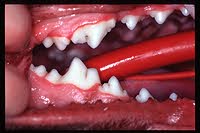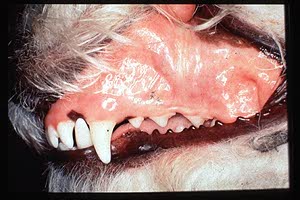

| September 2001 | Subscribers: 6,808 | Issue No: 023 - 23rd Edition | 2001© All Rights Reserved |


| September 2001 | Subscribers: 6,808 | Issue No: 023 - 23rd Edition | 2001© All Rights Reserved |
Maltese Only News
|
Oral Health For Dogs
|
 Fig 1: Inflamed gums (gingivitis) in a one year old dog. The gum line is swollen and red and the gums bleed when touched or brushed.
|
The first stage of periodontal disease is inflammation in the gingiva, i.e. gingivitis (Fig. 1). If plaque is not removed, the inflammation may spread and involve the periodontal ligament and jaw bone. As these tissues are destroyed the disease is called periodontitis (Figs. 2 and 3). The end result is loss of the tooth as the supporting apparatus of the tooth is progressively lost.
It is still not possible to entirely account for the mechanisms by which disease develops. Periodontal disease is a very complex disease in which the microbiology of the plaque as well as the inflammatory reactions of the host contribute to the destruction of the supporting apparatus of the tooth. We do know, however, that the frequent and thorough removal of plaque will prevent disease developing. Meticulous plaque control will also help prevent progression of disease in the affected animal.
Prevention and treatment
The prevention and treatment of periodontal disease has two components:
1. Maintenance of oral hygiene
2. Professional periodontal therapy.
Maintenance of oral hygiene is performed by the owner and is therefore also called home care. Optimal home care consist of daily effective plaque removal. The prevention and long term control of periodontal disease relies on adequate home care.
Professional periodontal therapy is performed by the veterinary surgeon under general anaesthesia and includes:
• supra- and sub-gingival scaling (to remove all deposits from the tooth surfaces both above and below the gum line),
• tooth crown polishing (to ensure a smooth tooth surface),
• and sometimes periodontal surgery
The practice of removing gross calculus deposits by the use of scalers in the conscious animal is not recommended for several reasons. The risk of causing injury to the gingiva and soft tissues of the mouth is high. Also, polishing is rarely possible in the conscious animal and a tooth surface which has been roughened by the use of scalers should always be polished to restore it to smoothness. A rough tooth surface will predispose to plaque accumulation.
It must be emphasised that the benefit of any professional periodontal therapy is short-lived unless followed up by effective home care. If no home care is instituted then plaque will rapidly reform after a professional periodontal therapy procedure and the disease will progress.
Maintenance of Oral Hygiene
Daily toothbrushing remains the single most effective way of removing plaque. Tooth brushing should be introduced gradually and as early in the animal’s life as possible. It is relatively easy to get a puppy to accept and even enjoy having its teeth brushed.
A variety of brushes for veterinary use are available. A toothbrush with soft or medium, round ended, nylon filaments is firm enough to be effective without causing discomfort. A flannel cloth folded over a finger, or a "finger brush" may be more comfortable for animals and owners, but is less effective than a nylon filament brush. The use of a finger brush or cloth during the training phase is useful, but every attempt should be made to get the animal to accept a proper tooth brush.
The use of a non-foaming tasty pet toothpaste is recommended. The paste should be pressed down into the bristles to maintain it on the brush or the animal will just lick it off and swallow it.
Brushing technique
The teeth and gingival margin are brushed in a circular motion. The brush is angled at a 45 degree angle so that the bristles will enter the gingival sulcus and shallow periodontal pockets. The circling motion should ensure that all cracks and crevices in and around the teeth are cleaned.
Some practical suggestions:
• Start dental homecare as early in life as possible as prevention of disease development is the aim. Moreover, it is easier to train young puppies and kittens to accept dental homecare than middle aged or older animals.
• Make the animal comfortable and approach from the side rather than in front.
• Start with just a few teeth and gradually increase the number of teeth cleaned each time until the whole mouth can be cleaned in a single session.
• The mouth does not need to be opened. It is mainly the outer surfaces of the teeth, especially at the gingival margin (where the gum and tooth meet), which need brushing. Tongue movement helps to clean the inner surfaces. Lifting the lip and cheek away from the teeth with the mouth closed will allow access to the outer surfaces of even the most posterior teeth in dogs with all head shapes.
• Offer a reward at the end of the procedure, e.g. a game or a treat such as a rawhide strip (not biscuits etc.).
• Include toothbrushing as part of the daily routine. Homecare is more likely to be acceptable to an older pet if it is introduced as an extension of a pre-existing routine e.g. evening meal, walk, grooming. You are also more likely to remember a consistent routine.
• Sit small dogs on your lap whilst brushing, at the same time cuddling them to reduce their apprehension; alternatively one person cuddles and restrains whilst a second performs the toothbrushing.
Even with ideal homecare in the form of daily toothbrushing, most animals will still need to have their teeth cleaned professionally at variable intervals. Most of us do brush our teeth daily but still require dental examinations and professional periodontal therapy at regular intervals.
Feed a balanced fibrous or dry food diet rather than a soft food diet. The act of chewing stimulates salivation, flushing the mouth with natural plaque retardants and physically removes some of the plaque from the teeth. At our present level of knowledge, there is no dietary texture which will maintain periodontal health in the absence of other plaque reducing measures.
The use of products aimed at encouraging chewing activity may be beneficial, by maximising the self cleansing effect of function and physiological stimulation of salivary flow and composition. A variety of hard biscuits, rawhide shapes or strips (and other natural products e.g. dried pigs ears, cows hooves), rubber and nylon toys are on the market. However, none of the products in this category have been shown to be as effective as tooth brushing. So, although these measures are helpful, they do not exclude the need for toothbrushing, dental check ups and professional periodontal therapy at regular intervals.
The chewing of bones is not generally recommended. Chewing on hard bone is likely to lead to tooth fractures, often with pulp exposure, and gingival lacerations. Softer bones will be chewed and swallowed, often causing digestive problems, or become impacted on or between teeth. Raw bones are also potential sources of infection for animals and owners (sarcocystis, toxoplasma, campylobacter, salmonella etc.).
 Fig. 5: A nine year old dog who has had his teeth brushed daily since he was a puppy. This is as healthy gums as you will ever see. The gingiva is pale pink, firmly adherent to the tooth and there are no dental deposits. This dog has healthier gums than most people. He has never needed professional periodontal therapy. Prevention really is possible! |
IN SUMMARY
Periodontal disease is preventable. Homecare should be started as early in the animal’s life as possible. Optimal homecare consists of daily tooth brushing with pet toothpaste. Clinically healthy gingivae can be achieved and maintained with rigorous plaque control (Fig. 5). Most animals will allow toothbrushing if introduced gradually and gently. The simultaneous use of products which encourage chewing activity are beneficial but should not replace toothbrushing.
Dr. Cecilia Gorrel B.Sc., M.A. Vet. M.B., D.D.S., M.R.C.V.S.
Special thanks to the author for use of this article Cecilia Gorrel is a Doctor of Dental Surgery, Oral
Pathologist, and Veterinary Surgeon. Dr. Gorrel is an Independent Consultant actively
involved in research into oral diseases in the dog and cat. She also runs Veterinary
Dentistry and Oral Surgery Referral clinics. She is President of the British Veterinary
Dental Association and President of the European Veterinary Dental Society. Dr. Gorrel
lectures and tutors courses in veterinary dentistry and oral surgery both in the U.K. and
abroad. She has written numerous articles on veterinary dentistry; and co-authored the
Handbook of Small Animal Oral Emergencies by Gorrel, Penman and Emily, published by
Pergamon Press 1993, as well as the Manual of Small Animal Dentistry, published by the
British Small Animal Veterinary Association 1995.
